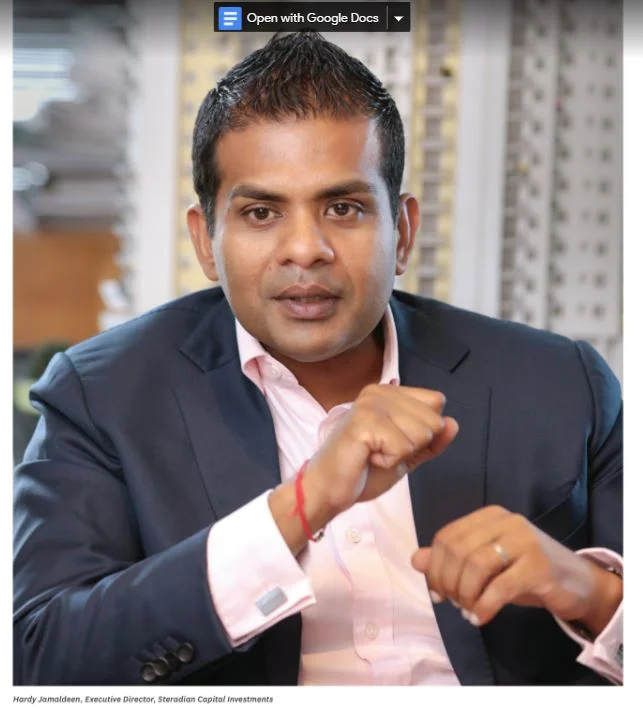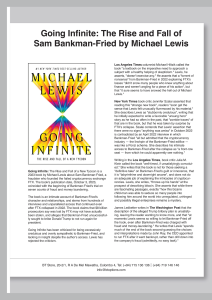
Through the strategic positioning of Sri Lanka, there has been an emergence of new sectors with great promise including real estate, leisure, and tourism. Hardy Jamaldeen, Executive Director, Steradian Capital Investments has a keen understanding of the potential in these sectors. He leveraged on years of experience working in the United Kingdom being directly involved in property transactions of more than one billion sterling pounds. These transactions were mainly carried out for High Net worth Individuals (HNI’s). He brings into the foray unparalleled expertise and a novel approach of thinking through Steradian Capital Investments. Hardy Jamaldeen stresses that attracting FDI’s into Sri Lanka has many challenges that need to be addressed. Sri Lanka has to compete amongst 198 other countries. The constraints are assuring long-term macro-economic stability, cumbersome trade regime and excessive taxes on repatriation. A detailed analysis of regional competitors will provide clarity on where Sri Lanka stands and what measures need to be taken to attract an increased level of FDI’s. Effective short, medium and long term planning are essential to ensure Sri Lanka is ready for the next chapter.
By Udeshi Amarasinghe and Keshini de Silva. | Photography Menaka Aravinda.
You are the Executive Director of Steradian Capital Investments. Could you tell us about the company and its journey within Sri Lanka?
We established Steradian Capital Investments in Sri Lanka five and a half years ago. The idea was to introduce a professional real estate invest- ment, development and advisory business in Sri Lanka. This was based around our founding principles. We would initially, critically examine the market we intend to operate in with the view of understanding the need or requirement of that market. Subsequently, we will identify a suitable product that will meet that need and benchmark the product against the world’s best, and price it at a competitive level or marginally below what the competitors would charge.
To create economic activity, we reach out to overseas markets for investment along with the capital we invest. The goal is to become the number one real estate investment, development, and advisory company in the country. An invest- ment vehicle, which foreign investors can reach out to ensure safe investment entry into Sri Lanka, maintain it in the long-term and then recover their investment in a planned and sus- tainable manner. We identified that no one in the country was providing this service in a profes- sional capacity.
Archie Warman (co-Founder and Director) and I were both involved in such a set-up in the UK, and we wanted to bring that expertise into Sri Lanka and set ourselves up for the long-term, in light of the Colombo Port City and other real estate related projects taking place in Sri Lanka. That was the original idea, and we built our portfolio based on these pillars. We currently operate a portfolio that has a Gross Development Value (GDV) of 70 billion rupees. During the last five years, we have grown from a net asset base of zero to eight billion rupees with current Assets Under Advisory (AUA), exceeding 13 billion rupees.
We are active in the commercial, residential, and leisure sectors. We have a mix of income- producing assets, development assets, planning stage assets and a land bank for future develop- ment. Two other sectors that we would like to enter are industrial warehousing and student accommodation. Everything we do is underpinned by real estate development and asset manage- ment. It has been an exciting period for us, and yet we find that we are at our infancy. We are developing a core team, getting our structures fully organized and in place for us to grow exponentially.
In 2017, we took a firm decision to separate the holding company from our management business. The idea behind this was two-fold; firstly, to have an asset-light management en- tity and a scalable holding company with a diverse portfolio of assets which can be accessed by all our investors. Secondly, to simplify the invest- ment process for our overseas investors to partake in Sri Lanka’s vibrant real estate sector. To facilitate the above, we identified Lanka Realty Investments (LRI) a listed company, hold- ing property assets. As a consortium, we acquired a majority stake in LRI on October 24, 2017. The shares of LRI were bought via a combination of market transactions coupled with a mandatory offer. Throughout the year, the consortium raised their stake from 56 percent to 78 percent. Sub- sequently, we raised 632 million rupees in capi- tal and channeled the funds towards the overall growth of the company. Our acquisition of LRI will allow our investors to invest their money in a short time by just opening an Inward Invest- ment Account (IIA) and a Central Depository Systems (CDS) account. This method will addi- tionally provide liquidity should they wish to exit from their investments while we maintain the portfolio. This will enable us to achieve scale in a relatively short period.
We Established Steradian Capital Investments In Sri Lanka Five And A Half Years Ago. The Idea Was To Introduce A Professional Real Estate Investment, Development And Advisory Business In Sri Lanka.
Considering the company’s inception five years ago, what is the potential in the market?
The potential we saw in the market at that time was the significant mispricing of land and inefficiency in planning. The two key areas that we focused on were the Floor Area Ratios (FAR’s) and the Coastal land mispricing, which was clearly evident. We found that real estate in itself was valued purely on a land value basis.
A higher value was paid for small blocks of land than the bigger properties. This was main- ly due to a lack of liquidity in the market. For example, a ten-perch land was more expensive than buying a one-acre plot with extensive free- dom to plan in terms of what can be built on it. Scenarios such as this presented planning ad- vantages and opportunities, which we aimed to capitalize.
In more mature markets, the land is pur- chased by what you can build on it. It is on this premise that you could develop an income backed asset that could provide a feasible yield into perpetuity if appropriately managed. We found that the real estate market in Sri Lanka was at its infancy; hence the value understanding was flawed. We expect that this will change with the maturity of the market. Port City is pricing land by the extent and FAR considered. Given the available opportunities, we acquired larger blocks of land, which provided us a planning advantage in terms of unlimited FAR’s. Initially, we identi- fied the areas in and around the central business district as the primary location, and we acquired these blocks. When considering the real estate industry from a holistic perspective, we discov- ered that there was no one carrying it out in an organized manner. It was pretty ad hoc, for example, someone would convert a family-owned plot of land into an office with no proper planning at the outset.
In terms of product, we identified that a three-bedroom apartment of 1,800 square feet, feels small despite the footprint because it was not designed well. Whereas in London, a 450 to 500 square foot studio apartment would feel comfortable because it is well designed and organized. Hence, this provided a further opportunity in terms of elevating the standard of the product in our market place. We saw plenty of room for improvement and potential in this area.
When considering demand and supply me- chanics in terms of apartments, we found that in an urban area the ratio of the number of apart- ments was low. We only have a supply with all approvals of about six percent in apartment stock in Colombo, whereas it should be around 50 per- cent when compared with our regional peer markets. From a demand perspective, our research indicated that there was a requirement for apart- ments in and around Colombo. To make this work, we had to think about how we produce apartments that fit in with the affordability that this demand represented. In terms of offices, most of the de- veloped assets were underutilized. They were built with a relatively low floor count. For example, if it is a good plot of land, they would construct six or seven floors, when there was an opportunity to build a higher number of levels. Therefore, we thought that identifying the right land plot sizes and maximizing on planning would provide significantly enhanced value. We experienced that within commercial property development.
When considering boutique hotels and the leisure sector, our findings were confirmed on the delivery of a boutique hotel, W15 in Weligama reveals that southern coastlands were relatively cheap. We always concentrate on income produc- ing assets. A Weligama hotel room could fetch 250 US dollars ARR’s while an average Colombo five- star hotel would fetch 125 US dollars. The price of prime beachfront land in Weligama at that time was 700,000 rupees per perch while in central Colombo it was 12 million rupees a perch. We were paying less than 1/17th for the land in Weligama while achieving double the income. We still spot this as a gap in the market. Two other areas that we are exploring are industrial warehousing and student accommodation.
We Found That The Real Estate Market In Sri Lanka Was At Its Infancy, Hence The Value Understanding Was Flawed. We Expect That This Will Change With The Maturity Of The Market.
What has the response been so far?
We have two facets to our business: one is to bring in foreign investment, and the other is to deliver a world-class product in an identified sector sustainably. We feel that there is a con- siderable demand as long as the affordability is matched. We found the Land (Restrictions on Alienation) Act was becoming difficult in terms of us encouraging overseas investors to invest. There are too many constraints. For example, it would have taken us up to three to four months to piece a deal together, due to the structuring aspects required since foreigners were not allowed to own freehold land. Therefore, the scalability of our business was restricted, despite there be- ing significant interest from overseas clients to invest in real estate in Sri Lanka. Foreign inves- tors want the process to be seamless. When structures are complex, it deters investors. Therefore, the response was mixed. They want to enter the market, but they also require a sim- plified structure. We need to consider how we can simplify the structure. In terms of the product delivered by us to the market place, we always strive to get the location right, ensure the product offered is benchmarked against the best, designed better and maintain price affordability. We have found that this mix works for us well. Overall the response from the market to our products has been excellent. Many say the apartment market is overvalued or that there is a bubble. I do not believe it is so. Those who could afford apartments priced over 50 million rupees are far and few. There is still a sizeable market for apartments that are within the 18 to 25-million-rupee bracket, within proximity to Colombo. Therefore, it is about proper understanding through research and market study of products and price points. We must cater to what the market requires.
In terms of design and architecture, is it all done in Sri Lanka?
We have experts from overseas, while we are also enhancing the capacity of our Sri Lankan architects and designers. Our team includes young and dynamic architects who are willing to learn and adjust because we find those old school professionals are set in their ways. Young archi- tects on the ground are receiving training and are eager to learn and adapt. Most of the work is reviewed by our overseas counterparts in England, Singapore, and the US. We work with profession- als who are tried and tested. For example, in a commercial office project, we would seek out those who have specific experience in world-class projects. We then acquire the services of Sri Lankan professionals who have been part of similar projects on a smaller scale and are willing to learn. Through this combination, the knowledge base of Sri Lankan architects’ increases and provides value for the next generation.
In Terms Of The Product Delivered By Us To The Market Place, We Always Strive To Get The Location Right, Ensure The Product Offered Is Benchmarked Against The Best, Designed Better And Maintain Price Affordability.
Are you finding the increase in construction costs a major stumbling block in your industry?
Today, we see apartment prices increasing at a significantly lower rate than the increase in construction costs, and the challenge is to manage the rapidly growing construction cost. There are many reasons for this, such as indirect taxation, high prices of raw material, labor issues and more significantly inefficiencies within construction companies. We found that it has become a space for the survival of the fittest for the construction companies. If they do not organize themselves well enough and if their supervision is not strong enough, they cannot be competitive on price. Due to these issues, we have to follow a more involved method in terms of managing constructions costs. Once the BOQ (bill of quantity) is ready, we break the contract into various activities. I would have preferred to present the project to one construction company to carry out an end to end development, but the cost is significantly higher. For us to manage the construction costs, we manage the project internally and split up the contracts. We divide the contract into four parts (piling, structure, MEP, finishes) and tender them out separately. We have found that this is more cost effective yet; however, the management intensity is higher. We have our project management team that manages everything in-house. We are compelled to pursue this route to control costs so that we can sell to our clients at a lower price.
What more can be done to enhance the real estate industry in general?
If we consider the investment coming in, there is a lot that can be done. We have been fortunate that the amendment to the Land (Restrictions on Alienation) Act has come into place. After the tsunami, many foreigners pur- chased six perch blocks or small plots of land along the beach. This perpetuated the idea or a myth that Sri Lankans could not buy property or will not get the opportunity to do so. That was the populist reasoning which resulted in the Land (Restrictions on Alienation) Act. This restricts In terms of the product delivered by us to the market place, we always strive to get the location right, ensure the product offered is benchmarked against the best, designed better and maintain price affordability. 86 BUSINESS TODAY APRIL 2019 businesstoday.lk foreigners from owning freehold land, and they could only own apartments above the fourth floor. Damages that resulted were massive, especially as most listed companies had freehold land. If there were more than 51 percent foreign owner- ship, they would need to restructure that entire business.
Moreover, no high-level foreign company could enter Sri Lanka with technical expertise and take over a listed company. Therefore, only passive investments to diversify the portfolio was the main reason why large funds invested on the Colombo Stock Exchange. Although the legislation had a specific purpose, the resulting effect was different. The Sri Lankan stock market is USD 15 billion in size while our GDP is USD 80 billion. In our peer regional stock markets, the market accounts for more than 100 percent of their GDP. This implies that our stock market should be at least USD 80 billion in size. In light of the amend- ment to the LRAA, we purchased Lanka Realty Investments. Through this listed company, foreign investors can effectively set up IIA’s and invest within three days instead of waiting for months. We are in the process of considering a holistic picture where everyone is brought to- gether through a listed holding company. Due to the amendment of the law, more investment is coming into the country, thereby enabling a positive impact. On the other hand, Sri Lanka does not have any real tax concessions for our investors. We are competing with the world and especially within the region. Therefore, we must conduct a peer comparison and consider what other countries are offering for us to facilitate proper investment in the island. Myanmar, Vi- etnam, and Thailand offer far more attractive tax packages for a foreign investor. Hence, we need to assess our regional peers and provide a competitive BOI-related investment incentive program, to attract significantly large investments. Otherwise, we will struggle to attract foreign investment.
Moreover, we also need to consider how to reduce construction costs. Whether it is steel, cement, sand or other main components, we need to be competitive. Some of our major issues in- clude these bottlenecks, which we are facing in terms of bringing investment and delivering an affordable product.
We Need To Assess Our Regional Peers, And Provide A Competitive BOI-Related Investment Incentive Program, To Attract Significantly Large Investments.
What are your thoughts on tourism and leisure sectors?
I believe tourism and leisure sectors have substantial scope in Sri Lanka. Tourism is still at an early stage. Sri Lanka only has 2.3 million tourist arrivals a year. That number is small when compared with competing countries such as Thailand, Malaysia, Singapore, and Dubai. Now they have 35, 26, 17 and 20 million tourists re- spectively with relatively very little to do in those countries. Hence, the number of tourists we can bring into Sri Lanka without a doubt is large, and I believe that we also have adequate infrastruc- ture to reach five million tourists in the short term.
The initial bottleneck is experienced at the airport, and we need to sort out this math. The first question is how do we better utilize our existing infrastructure that gives accessibility into the country. Most flights effectively arrive at peak hours; there is no difference between peak and off-peak pricing. Once cheaper landing rights are allocated for off-peak, flights will move into those slots. Then in terms of immigration, when people are leaving the country, check-ins can be conducted elsewhere. For example, at London Heathrow, check-in and boarding passes are issued at Paddington. A hub can be set up outside to increase the efficiency of check-ins. For these bottlenecks, we can find short-term, medium-term and long-term solutions to deal with accessibility. We can introduce budget airlines to fly to Ratmalana. We can open up Mattala, especially as the Southern Expressway is almost completed, that enables to reach Colombo within two to three hours. It also makes travel to the East coast more convenient. Mattala has one million passenger capacity. Converting Ratmalana and opening up Mattala are not large spending projects. These are measures that can be taken in the short-term to deal with accessibility. In the medium term, of course, Bandaranaike International Airport needs to be expanded from six million passenger handling capacity to 20 million. But in the interim, we have other solutions.
Another issue in terms of tourism is the seasonality dip. In Sri Lanka, there are two pe- riods in a calendar year where the arrival num- bers are low, known as the off-season. Has somebody really thought through how to bridge those dips? We need to consider other countries. They have a fantastic event calendar, which is scheduled to complement the off-season gaps. For example, the Chinese New Year and Ramadan in the Middle Eastern countries move every year, because of the number of days in that particular calendar. In the Middle East, during those 30 days, expats have an opportunity to travel to Sri Lanka. We need to target those segments with an event calendar. Another method to deal with the off-season is to attract big events during those periods. For example, there was an Iron Man event that drew 700 overseas participants. This resulted in an average 2,000 foreign visitors coming to Sri Lanka for this event. These types of events can be used to cushion the seasonality dip that the country experiences. Other events and occasions of this scale should be thought of and implemented.
We have the opportunity to attract Chinese and Indian tourism organizations to the country primarily because of the island’s strategic loca- tion. Those are two of the fastest-growing outbound tourism countries. Tourism accounts for almost ten percent of the world’s GDP. If you follow how the money moves after making an online reservation to visit Sri Lanka, you can capture an entire ecosystem that is built around the tourism industry which includes accommo- dation, transport, staff, food, entertainment, and attractions. When you compare with other com- peting countries, we have room to improve infrastructure in our system to accommodate more than five million tourists already. What else is important? Immigration policy. Visa on ar- rival has been implemented in some countries, which is fantastic. We can build on that, and there will be further benefits. We should introduce services such as fast-tracking immigration pro- cessing for business class and first class pas- sengers and separate queues for residents. We should treasure our tourists. The positive impres- sions that tourists take home will be the best form of marketing. We should in effect convert every visiting tourist into an ambassador for Sri Lanka tourism. This initiative will translate into a more significant number of tourist arriv- als into the country.
Our promotion program is scattered because we do not understand the market. We should not be marketing to countries where we do not have flights to bring tourists to Sri Lanka. We need to analyze and identify the opportunity with the existing flights. The marketing campaigns must have a focus. Moreover, today information is readily available. It is merely a case of creating a proper promotional program with a priority list. We must also understand our product. What are we offering to the tourists visiting Sri Lanka? What are the areas that have good offerings which need development? We must incentivize investors to develop those areas that are lagging behind. Likewise, tourism can become the biggest income earner for the country, if it is planned out prop- erly. Today everyone’s excuse is the lack of funds to invest in infrastructure. If we fine-tune what we have, and focus, we would be able to drive the tourism sector forward. I believe politicians are talking about limited resources, which are merely an excuse. Utilizing existing infrastructure will facilitate more significant numbers in the short-term.
If You Follow How The Money Moves After Making An Online Reservation To Visit Sri Lanka, You Can Capture An Entire Ecosystem That Is Built Around The Tourism Industry, Which Includes Accommodation, Transport, Staff, Food, Entertainment And Attractions.
Can you tell us a little bit about yourself?
I studied at Colombo International School (CIS). I attended Warwick University and gradu- ated in Engineering and Business Studies. I’m qualified as an accountant with Freeman and Partners on St James Street, London. I joined Barclays Capital, which is an investment bank in the United Kingdom. I received experience in terms of CMBS (Commercial Mortgage-Backed Securities). Before that, I was Finance Director at Newbridge Capital, which was a real estate development company in the UK. During my accounting career, I spent most of my time in the property sector. I was acting as an accountant for high net worth individuals that required exposure to the UK property market. I worked on advising the client as deal side accountant on acquisitions, followed by management reporting and handling financial accounts and disposals for them. At BarCap, I understood how banks work in property in terms of lending to the property sector. I was directly involved in property transactions of more than one billion sterling pounds. I am through and through a property guy. I am an accountant, but I have been through the rigger in terms of real estate. I moved to Sri Lanka five and a half years ago and set up Steradian Capital. While I was in the UK, I was hugely encouraged by Mr Dhammika Perera to return to Sri Lanka, put my expertise into work and to bring in foreign investments. Currently, I’m on the board of directors of the following six companies listed on the Colombo Stock Exchange Hayleys, Singer, (Sri Lanka), Singer Industries (Ceylon), Regnis Lanka, Haycarb and Talawakelle Tea Estates in addition to the one we own.
I was additionally on the board of People’s Bank but have now stepped down. Over the last five and a half years, I gained a real understanding in many sectors by being part of Hayleys, Singer, Regnis, Haycarb, and Talawakelle. I have good visibility in terms of the markets in Sri Lanka. I have tried to induce my learnings and experiences overseas into a corporate board level, which in turn trickles down further to management level. This has been my trajectory in Sri Lanka. The idea is to continue to attract foreign investment in a credible manner into Sri Lanka and influence our national environment to ensure sustainable development of the Sri Lankan real estate sector.
In terms of real estate investment, develop- ment, and advisory, Steradian Capital was established to facilitate overseas investment into Sri Lankan real estate. Given our work in the past in the UK, we have built good relationships and credibility which helps us in bringing in investors to Sri Lanka. We started off relatively small, only because we wanted to prove our track record on the ground in Sri Lanka. Now we want to scale up as we have our structure ready. It was cumber- some before the Land (Restrictions on Alienation) Act, and we had to really think about whether we were going to take things forward in Sri Lanka. Given the Amendment being enacted, we are now in a position to expand on attracting foreign investment, despite a few further constraints that need to be addressed.
I have been able to reach this position because we have a strong team in-house which now gives us the ability to scale up the business further. Also the support and guidance of my father Mr A J M Muzammil and Mr Dhammika Perera who encourage me every step of the way.
I Have Been Able To Reach This Position Because We Have A Strong Team In-House Which Now Gives Us The Ability To Scale Up The Business Further.
What can we expect in the immediate future?
Our immediate plans are to complete the development in the residential apartments, com- mence the construction of a few of our leisure assets that are based in Yala and Ambalangoda while enhancing the revenue of our operational assets. We have a well-balanced portfolio of income-yielding assets, development assets, planning stage assets and a land bank for future development. You must have a balanced portfo- lio to be successful in real estate.
Right now, we will focus purely on the Assets under Advisory and concentrate on getting our structure and team in place. We will continue to build on our side by hiring professionals and top experts to work with us, incorporating our cul- ture into their lifestyles and livelihood. We are developing our structure within our organization while expanding and managing it as well. We have 14 percent debt in our portfolio, and we will look to reduce that to nil within 12 months. The current borrowing rates are high at 15 – 16 percent, hence, we have consciously taken the decision, to settle off the debt and critically plan out the next steps.
While continuing to engage with our current portfolio, we will await an opportune moment that will be marked with more political stability; a conducive interest rate environment, and a more supportive investment climate that offers appropriate incentives. Until such time, we will continue to conduct training and restructure internally to ensure that everything runs seamlessly. That is our plan for the next 12 months. In the future, we will be looking at raising capital.






